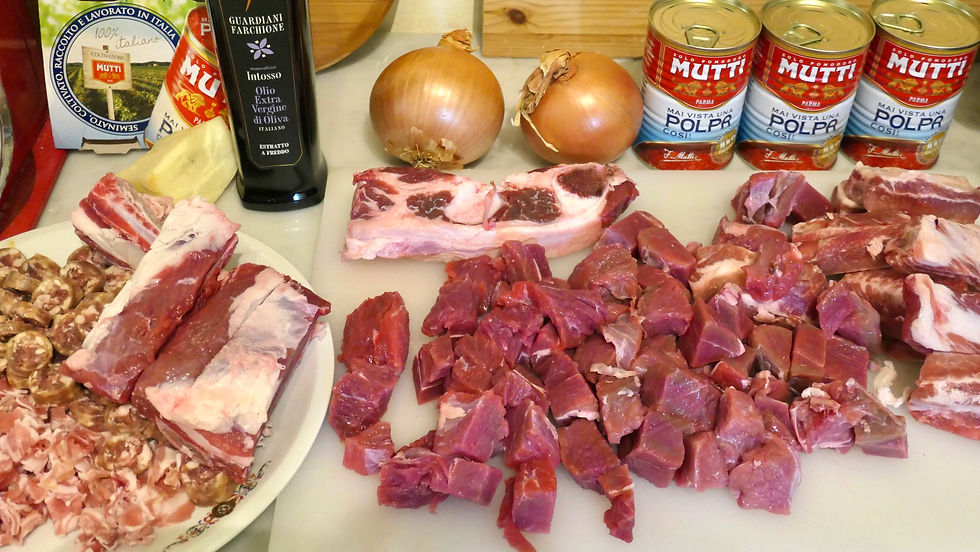Caponata
- Mike
- Jun 24, 2021
- 4 min read
Updated: Dec 12, 2024
Caponata is a unique dish that is classically Sicilian and as such reflects the history of the island and is a perfect ensemble of the great ingredients that are to be found in Sicily. This has to be one of the best ways to use melanzane (eggplants) which grow well in a hot climate and thrive in poor soil. Choose medium sized viola eggplants if you can because the larger ones are too spongy and can sometimes be bitter.
Caponata is not one of those recipes that you need to stick to religiously because even in Sicily it varies from town to town quite considerably. Also, the ingredients can change from summer to winter (seasonality is fundamental to Italian cooking) and the proportions of the various ingredients are also subject to change.
Our recipe below reflects the way we personally prefer to make Caponata after trying lots of different variations and it’s a summer version, or at least a nine months of the year version because it requires good fresh tomatoes. Caponata has something in common with the classic French ratatouille in that the final dish should not taste of any one ingredient at the expense of the others; it should be a true amalgamation of flavors.
But Caponata is unique in the sense that the agrodolce element is fundamental and without it, it’s just not Caponata and on this point every recipe is in agreement. The balance of sweet and sour needs to be just right so in the mouth you think it’s sweet one moment and then the very next moment you think it’s sour and your taste buds remain confused throughout. Restaurants, even in Italy, often err on the side of sweetness to avoid disappointing diners who are not familiar with the dish but that is a mistake and just as bad as using too much vinegar.

We prefer to use almonds instead of the more commonly used pine nuts because we find that with all the strong flavors, pine nuts get lost in the shuffle whereas almonds hold their own and their crunch is a great counterpoise to the softness of all the other ingredients. Almonds are also a genuine Sicilian product.
Finally, this is a dish that requires a lot of chopping and sequential cooking so it's impossible to make it properly in under 90 minutes, therefore it’s worth making a decent quantity either for a large group or for keeping in the fridge or freezer. Don’t chop everything too finely otherwise it will become mushy and at the end of the process you should be able to visually identify the different ingredients in the final dish. It can be eaten warm or at room temperature as an appetizer, a side dish or a simple lunch with fresh bread.
Ingredients for 6-8 people:
850 grams ( 30 oz ) eggplant
280 grams ( 10 oz ) chopped yellow onions
280 grams (10 oz ) chopped celery
280 grams ( 10 oz ) tomatoes, halved or quartered
160 grams ( 5-6 oz ) olives denocciolate (big green Castelvetrano olives from Sicily would be our choice)
70 grams ( 2.5 oz ) blanched almonds
45 grams ( 1.5 oz ) capers
45 grams ( 1.5 oz ) raisins
a little tomato concentrate
2 cloves garlic, peeled but left whole
3 flat teaspoons sugar
up to one third cup of red wine vinegar
big handful of fresh basil
orange zest
extra virgin Italian olive oil
salt and freshly ground black pepper
Directions:
1. Heat the oven to 190 celsius ( 375 F) and toast the almonds for about 6 minutes until golden and chop roughly.
2. Meanwhile chop the aubergines into 1 inch cubes, salt generously and put them into a bowl with a generous amount of oil. Mix the aubergine pieces by hand so they’re all well oiled then spread them out on a baking sheet in a single level and put the tray in the oven with a timer set for about 25 minutes.
3. While the eggplant is cooking, oil a large frying pan very generously and add the onions, celery and garlic. Cook for 10-12 minutes on a medium high heat, adding salt and pepper after a few minutes to release the liquid content which will prevent the vegetables from coloring.
4. Add the tomatoes and a little tomato concentrate and continue cooking on low heat for another 10 minutes.
5. Discard the garlic and add the cooked eggplant, capers, olives, raisins and chopped almonds and mix well.
6. Mix together the sugar and vinegar and then pour into the pan and stir everything well.
Bring the mixture to the boil briefly than turn off the heat and add the basil torn into small pieces.
7. Check for seasoning and consistency, add more olive oil if necessary. Adjust the vinegar and sugar if required to get the agrodolce flavor just right, but make small adjustments only until it's perfect.
8. Cover the pan with foil and leave for 30 minutes off the heat for all the flavors to infuse properly
9. Serve topped with some fresh basil and zest of orange.



